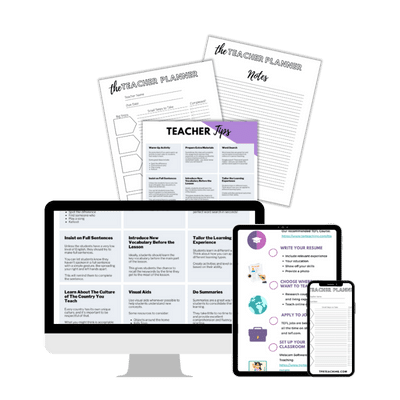ESL warm-up activities are a great way to get students motivated and excited for the English lesson. They are usually played at the beginning of class and set the tone for the entire class.
Rather than sitting down and piling up the grammar exercises and new keywords, warm-up activities can help English students see the language in a more positive way.
These are some of my favorite ESL warmers for students. The tasks are designed to get the students’ mentally warmed up and ready for class.
ESL Warm Up Activities
- Find Someone Who
- Picture Prompt
- Would You Rather
- Two Truths One Lie
- Odd One Out
- Spot the Difference
- Describe the Picture
- Find the Objects in the Picture
- Show and Tell
- Listening to Piano Music
- Free-Writing Activity
- Hot Potato
- Shape Hunt
- Listening and Speaking Game
- Simon Says
- The Categories Game (Stop the Bus)
- Warm Up Questions
- Small Talk
- Hot Seat
1. Find Someone Who
Find someone who is a versatile ESL warm-up activity and icebreaker. It is suitable for adults and children.
It can be played in many ways, for example, to practice a specific tense, encourage students to form questions, or some other target language.
For example,
Find someone who can say the English word for *picture*
Find someone who has visited England (encourages the student to ask the question using the present perfect tense)
Find someone who loves chocolate (getting-to-know-you exercises suitable for the first day of class)
The activities can be made more difficult by selecting pronouns or questions with conditionals. You can find many “Find Someone Who” activity sheets on ISL Collective.
2. Picture Prompt
Picture prompt is one of the simplest games you can play with ESL students, from beginner to advanced.
Introduce a new topic by showing the students a picture of the topic you are studying. This may be a good way to get students thinking more deeply about the subject and recalling some keywords or vocabulary words related to the topic.
Beginners will be able to point out things they can see in the picture, such as flowers, trees, bikes, and children. You can ask the students questions, such as “what are the children doing?” and encourage full sentences if you think they are capable.
Intermediate-level students may be able to expand on their answers and provide complete sentences. They can give much more descriptive answers.
Advanced students may be able to form a story around the picture or describe what’s happening.
You may also be interested in: Best ESL Icebreaker Activities and Games
3. Would You Rather
Would you rather is a game that can be played with ESL students. It’s an effective way to review vocabulary, sentence structure, and idioms.
You can play would you rather on your own, in pairs or in groups with students. Students must decide which they prefer, for example, whether they would rather eat strawberries or drink iced tea.
Beginners may struggle with this game because it requires them to use higher-order thinking skills, such as comparing two options and deciding which they prefer.
Intermediate-level learners shouldn’t have any difficulty, and they can practice using the past tense, choosing between comparatives (such as “better” or “worse”), or using conditional sentences.
Advanced learners may want to try this game with more than two options or play using conditional sentences.
Rather than think of all the “Would You Rather” questions yourself, you can ask the students to create their own questions and ask other students. You could answer the questions in pairs, groups, or as a class.
A simple Google search of “would you rather” questions will help you find a plethora of questions you can ask.
4. Two Truths One Lie
“Two Truths One Lie” is a classic game usually played in pairs or groups. Each student has to make up at least two truths and one lie.
Students are given some topics to choose from, such as movies, sports, hobbies, or perhaps a particular tense to focus on.
Beginners may struggle with this game because they often have trouble formulating a believable answer if they haven’t heard of the topic before.
Intermediate-level learners should be able to participate in this activity effectively. They will need to be able to form a response quickly and convincingly for any topic given.
Advanced learners will not have any problem creating lies and truths on their own. They may want to think about the believability of their responses when playing this game.

For English Language Teachers or Those Looking to Get Started…
Teacher tips, new teacher checklist, teacher planner, and notes. Subscribe for ESL News, jobs, and more!
5. Odd One Out
EFL students love pointing the odd one out in pictures, making it a great ESL warm-up activity.
You can show groups of pictures that relate to the topic of study. Students choose which picture is the odd one out and explain why it is the odd one out.
This game is ideal for lower-level students and young learners who are still building their knowledge about categories or things.
Alternatively, if you don’t have pictures, you can write the words on the board—for example, Halloween, Christmas, Easter, and Wednesday.
6. Spot the Difference
Kids in elementary or primary school love the ESL warm-up game “Spot the Difference.”
If you can find a picture related to the topic you’re studying, start the class by asking the students to notice the difference between the pictures.
The difference could be a slight change in color or the position of something.
This game is ideal for any level learner because it doesn’t ask them to use many higher-order thinking skills. It’s simply about noticing differences and pointing out what they are.
You can make this activity more challenging by asking questions related to the difference in the pictures, such as “What color are the children’s outfits?” or “How many people are wearing hats?
7. Describe the Picture
You can play this ESL game with two partners. Show one person in each pair a picture with a lot of detail in it. Then the student has to describe the picture to their partner in 30 seconds. Their partner has to draw the picture based on the description. The team with the closest matching picture wins.
This game is ideal for any level learner but may be more challenging if you’re not using pictures related to your study topic.
You may also be interested in: Best Free ESL Worksheets for Kids
8. Find the Objects in the Picture
Similar to “Where’s Wally” but for English language learners!
This game involving pictures is “Find the Object in the Picture.” In this game, students have to find the specific items in a busy picture. Students would have to describe the location of the objects using prepositions of place, making it suitable for beginner learners.
The teacher could also have a competition to see which student can find the object in the picture first. The students can run up to the board and circle or touch the object when they find it.
9. Show and Tell
The game “Show and Tell” is a simple ESL game that can be played any time with any group of students.
In the game, one student will have to draw or bring in an item to the front of the class. They then have to show it to their classmates and talk about it for 1-2 minutes. The other students can ask questions.
Advanced learners may want to use this game to make jokes or tell funny stories about pictures or items they may bring.
This game can also be played as a competition. Students have to fill out a sentence with the words, “I brought in _____ because it’s ______.”
This game can be continued throughout the year, with a different student making the presentation each day.
Useful Links
10. Listening to Piano Music
Not exactly a warm-up activity, but some teachers play classical music before class begins or when doing a creative exercise.
Classical music, such as Mozart and Beethoven, is an excellent way of calming everyone down, especially if they are giddy young children.
Classical music is known to have some benefits for all ages and can be incorporated into your routine:
- Creates a calming effect
- Improves concentration skills
- Improves creativity
- Improves brain function
11. Free-Writing Activity
A free-writing activity is a way of relaxing the student and teaching them useful skills such as brainstorming. The students hopefully will improve their writing speed by practicing this simple activity throughout the semester.
A free-writing game can be related to your lesson, with students writing about the topic and their experiences.
For example, you could tell them to write about their childhood memories, favorite food, or daily routine.
Sometimes, it may not be related to a lesson at all and simply involves students expressing themselves before class begins or while doing another creative exercise.
To start the game, students are given 5-10 minutes to write on any topic you choose. After that time has elapsed, students can share their responses.
No erasers and dictionaries are required! The game aims to improve students’ writing fluency in a more relaxed way. It is not recommended for ESL learners in the beginning stages of learning English.
12. Hot Potato
Students stand in a circle and pass an object around. When the timer goes off, or the music stops, the student holding the hot potato has to do something.
For example, the students have to describe the object as they are passing it, only using positive adjectives. If they say the wrong adjective (such as “It’s ugly”) or can’t think of anything else to say, then they get sent out of the circle.
Hot Potato is a fun warm-up activity that could also be used to practice asking questions, verbs, or new vocabulary.
This game can also be made into a competition by seeing who gets sent out last.
13. Shape Hunt
Students explore the classroom and find any object that is in the shape of a circle, square, rectangle, triangle, or star. After they bring that object back to their desks, they write down the shape’s name and what it is.
This activity can be a warm-up game for some teachers, as it is related to identifying shapes (a skill some young kids have problems with).
Additionally, this ESL warm-up activity allows students to walk around the classroom to familiarize themselves if they are new.
14. Listening and Speaking Game
Students are given a word prompt and have to speak about it for no more than twenty seconds. The other students in their pair or group will act like radio hosts and interview them.
When the time is up, the interview can be over, and another student will take their place.
Some ideas for a word prompt include:
- Best movie you’ve ever seen
- Best vacation you’ve ever had
- Your favorite food
- Your worst subject in school and why it’s so hard to learn.
15. Simon Says
Sometimes even just saying the words “Simon Says” makes students crack a smile. This is especially true for younger students who know what “Simon Says” means.
The students will have to do everything Simon says. It can be a good way of preparing children for English classes by taking them out of their seats and moving them, even if just for a minute.
“Simon Says” is a good way to practice action verbs and body parts, like, “Simon says put your hands on your head!” or even animals: “Simon says act like a monkey!”
If you give an order without saying “Simon says” at the beginning of the sentence and the student does the action anyway, then they lose and sit down!
16. The Categories Game (Stop The Bus!)
This one is a great activity to get students engaged before class begins. The teacher will say a letter of the alphabet, and the students have to think of things that start with that letter.
Start the lesson by choosing some categories, such as animals, colors, fruit or vegetables, numbers, shapes, and seasons. Give the students time to copy the categories into their notebooks.
The teacher calls out a random alphabet letter, for example, C. The students have to find a word that begins with each category’s letter ‘C’.
The first student to come up with a word for each category wins.
17. Warm-Up Questions
Rather than answering the teacher’s questions, the students are encouraged to prepare their own questions.
The teacher can give the intermediate or advanced students a topic, and students in groups have to write down a single question they could ask related to that topic.
For example, if your topic is social media, students could prepare questions such as:
- How often do you use social media?
- What are the benefits of social media?
- What can you do on social media?
- Do your grandparents use social media?
The questions should be engaging with no yes/no questions. Students can also make this into a survey by asking ten students in the class and noting down their answers on a piece of paper.
They can share their interesting findings with the class.
18. Small Talk
A simple game, yet an important skill, is small talk. This is a suitable activity for teens and adult students.
The best part about small talk is that it requires almost no preparation for busy teachers like us!
The teacher writes some questions or a topic on the board, and students have to stand up and talk to others about it in the classroom.
19. Hot Seat
This is said to be the mother of all ESL warm-ups. The whole class can get involved in this one and have a lot of fun.
Prepare a list of vocabulary words from the previous classes. Bring a chair to the front of the class and split the class into two teams.
One student from the first team can sit on the “hot seat” facing the class. Make sure they cannot see the whiteboard.
Set a time limit (say 1 minute) and write a vocabulary word on the whiteboard. The team must say things related to the word until their teammates guess correctly. Continue until the time runs out. The team that has the most correct answers wins!
Conclusion
These warmer activities will get your class on the right foot and set the tone for an enjoyable English class. I hope you enjoyed these fun ESL warm-up activities and use them in your next lesson!
Online Teacher Toolkit
Be IN The Know
Get the latest jobs, news, and opportunities delivered directly to your inbox by joining my exclusive community. Grab my teacher planner, teacher checklist and tips now. Sign up here.
GEt Certified
Start your teaching journey and get certified now. Watch my YouTube video about how I got started, or read about my experience here: The TEFL Academy review.
START Your First Teaching JOb
New to the world of online teaching or just want to fill some hours in? Curious if this is a career you want to pursue? Check out Cambly to get started. Read the Cambly review.
Highest-Paying Online Teaching Jobs
In my post, I cover a list of some of the highest-paying online teaching jobs. Alternatively, use the curriculum online and find your own students. It’s easier than you think!
ACCEPT PAYMENTS ONLINE and Save money
Use Wise to accept payments from overseas. Wise has the lowest exchange rates that I am currently using right now. Get Wise.
Caitriona Maria is an education writer and founder of TPR Teaching, crafting inspiring pieces that promote the importance of developing new skills. For 7 years, she has been committed to providing students with the best learning opportunities possible, both domestically and abroad. Dedicated to unlocking students' potential, Caitriona has taught English in several countries and continues to explore new cultures through her travels.


